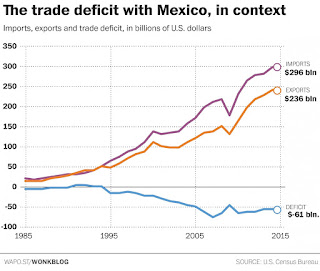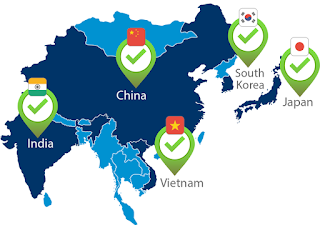 |
| But Where Does The Money Go From There? |
When you start thinking about all the money and jobs we shift into
Mexico each year you would think by now Mexico would be rolling in cash.
Interesting trade deficit data concerning Mexico reveal a fact most
people miss. A bit of research quickly confirms that the money Mexico
receives by way of trading with America quickly passes through its
lands and flows to Asia. It could be argued that when all is said and done we
are still transferring our wealth to the far east only by the scenic
route.
The true size of our trade deficit with Mexico is difficult to get a handle on, some figures show it as around 102 billion dollars in 2019. What
really stands out is where Mexico sends this trade
income. The following numbers show that when it comes to trade in 2019
exports of goods and services made up about 39% of Mexico’s GDP but
even with a huge trade surplus with the United States, Mexico still ran
an overall trade deficit. This is the reasoning behind substantially strengthening NAFTA
but in a way that gives a great deal more value to the United States.
 |
| Once Wealth flows To Asia, It Stays There |
For years the overspending of consumers here in the United States has allowed countries like China, South Korea, and
Japan to sell as far more than we export. We have enriched them through what often seems like rather
lopsided trade arrangements, and during that time we have watched them
grow stronger as we have weakened.
Those preaching the virtues of
globalism and free trade point out that American consumers pay far lower
prices because of this but overlook the fact that in the long run such
an unbalance will not end well.
The bottom-line is the United States not only
directly but even indirectly is shipping wealth off to Asia, this means such trade poses a far bigger issue than what is seen as the imbalance with our NAFTA partners.
This article ties in with several others published on AdvancingTime. One delves into
how China has not been fair in trading with America and how a very
strong strategic dimension exists for NAFTA and a powerful regional
trade bloc to compete in a changing global economy. The second explores the strong business relationship between Japan and China that has grown stronger since Japan imploded decades ago. This tight relationship is apparent each time trouble surfaces in China. It seems, the yen jumps in value as wealth in a stealth move flees China through business back-channels. This should not be misinterpreted as the
yen strengthening, but rather a temporary bump before the wealth moves
on to an even safer place.
It is likely the controversy over just how much trade contributes to America’s
economic growth will be ramped up as growth slows. Trade between
countries is given far too much credit for being a big driver of our
economy. It pales next to factors such as government spending and credit
expansion. The fact is if John needs to buy a wheelbarrow for work it
does not matter where it is built. John needs and will buy a
wheelbarrow. Where trade does fit into this has to do with what country employs workers to make that wheelbarrow and how much it will cost.
While John may save money if the wheelbarrow was produced in a low-wage
country trade has more to do with who benefits from commerce rather than a force driving our economy forward.In many ways, trade should be seen as a way to increase access to a
greater variety of goods at a better price but this only works over a
long period of time if it is balanced. A county that constantly
enjoys a trade surplus at the expense of its trade partners often
reaches a position to exploit the weaker countries and generally does
so.
Throughout history, trade policies have had massive long-term
ramifications on the strength of a nation’s economy. The recent promise by politicians that
increased trade will
create new jobs has turned out to be largely a
myth. Still, we hear the narrative spun by politicians playing the “fear
card” with statements such as “We
can’t let countries like China write the rules of the global economy.”
This implies we will lose the power to control our own fate if we stand
firm and protect what is ours.
The big driver for free trade has always been big companies wanting to
expand their markets and exploit ways to reduce labor costs. This is where it is important to remember it is not all about human labor but technology is playing a greater role in production. If factories filled with mostly robot workers are the future then we
should do all that we can to see that they are located in America. While
they would not necessarily be a massive creator of jobs they would at
least allow us to have control of our own manufacturing and reduce
America’s trade deficit. Fortunately, several events that have taken
place since then have fed into an awareness of the vulnerabilities
created by allowing control of production to flow into foreign hands.
Footnote; For more on this subject see the link below.
http://Nafta And Regional Trade Better than Buying From China.html
(Republishing of this article welcomed with reference to Bruce Wilds/AdvancingTime Blog)





